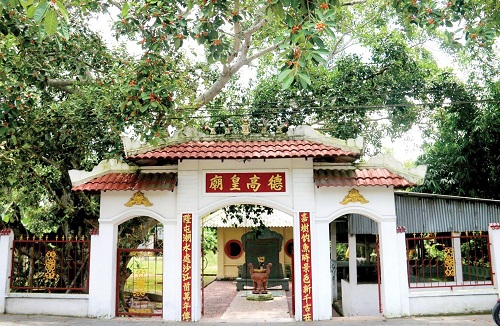
Prominent among them is the plantation policy - which was implemented by Lord Nguyen Anh in the late 18th century. At that time, he thought that "Sending troops back to farm" was a good plan, so he ordered the army to break the field in Thao Cau (Vam Co) to name it the plantation camp. Again gave orders to the officials and the people, whoever recruited 10 people or more, they were appointed as camp warden. Since then, many plantation departments have been established in many places. The local government lends seed to farmers and provides cattle and buffaloes. Those who work in the fields are exempted from doing labor. It is forbidden to kill buffaloes and leave fields fallow. Gia Dinh's land has been greatly expanded thanks to these encouraging solutions.
In 1802, Gia Long Emperor continued to promulgate the policy of establishing plantations in the South, aiming at the following benefits: expand the field area, increase food production; increase income for the imperial court; guaranteed the right to rule and control of the court over the new land. This policy mainly relies on recruiting poor people, criminals, and soldiers to carry out the clearing of wasteland. During the reclamation period, this population will be managed in a plantation way, unlike a normal hamlet; After 6-10 years, when life is stable, it will change to the form of a village, the land is managed by the commune, and will have to pay taxes. Plantation occurs most often in Gia Dinh area. The largest plantation establishment was organized by the Southern Emissary Nguyen Tri Phuong in 1853-1854, establishing 21 bases and 124 hamlets in all 6 provinces.
Another form is the joint land reclamation jointly by the imperial court and the people, this policy was born in the Nguyen Dynasty at the proposal of the Military Counselor of the North citadel Nguyen Cong Tru. This policy aimed at emigrating to establish a new hamlet, started in 1828 under Minh Mang Emperor. The method is specified as follows, the imperial court will invest the initial capital, appoint an official to recruit and direct the people to reclaim land in two cases: the number of people recruited is 50 people enough for a commune, the person who stands out to recruit will be given the position of commune chief; The number of people recruited is 30 people, enough for a hamlet, the person who recruits will be appointed as the chief of the hamlet. During the first 6 months, the imperial court will provide the people to reclaim enough food and means of production; From the 7th month, you have to take care of yourself. The imperial court will exempt these new hamlets and communes from tax for 3 years.

The policies on reclaiming and establishing new villages in the South of the Nguyen Dynasty helped this land develop more and more. In the photo: An ancient canal in Lai Nien area (now in Go Quao district, Kien Giang province). Photo source: DUY KHOI
During the reign of Tu Duc Emperor, in the Six southern provinces of the South, the task of reclaiming and establishing villages was strongly encouraged by the state. The landlords are usually landowners who lend money to farmers to buy boats, farm tools, food, clothes, and money to spend in the early days of the reclamation. After the harvest, the borrower has to pay the debt and interest. Another form is that the landlord directly manages and exploits agricultural land. They hire workers (tenants) to work long-term, pay wages and give advance payments. If for some reason there is no money to pay the debt, then a relative must replace the debt.
The application for the establishment of a new village consists of two copies, presented to the Administration Commissioner. In specific, it is clearly listed: the border on four sides of the new village, the names of the patriarchs, the name of the landowner, the type of land, the new village name, application for exemption from tax, 3-year military service, write down names of people for management and taxation. If the files and facts are reasonable, the application for establishing a new village will be checked and confirmed by the government in the presence of representatives of the neighboring villages. If all goes well, the government will recognize the village chief, and issue a small seal... After that, the local government prepared a report, and presented to the Administration Commissioner the order of work, together with the newly drawn village map, which was signed by the village chiefs of the neighboring villages.
When receiving the report, the Administration Commissioner reports to the General Governor. If accepted, the General Governor will approve the report. Finally, a copy with criticism will be sent back to the local government and district. The government and district officials have to go to the new village for the second time to make an examination sheet. This sheet clearly states that he has arrived, confirmed the area, and type of land, and signed by the wardens and adjacent village chiefs. The bottom is the signature of the village head, the newly established village body. During the reign of King Tu Duc, with the wasteland, the person who applied for the reclamation was accepted as the owner of the land. There are regulations as follows: Those who leave uncultivated land without paying taxes will be taken back and assigned to other people to pay taxes. Failure to pay taxes may result in loss of land. If you want to pay taxes, you must register locally. If you want to register, you must follow the procedure.
In the southern countryside of the Nguyen Dynasty, the process of reclaiming wasteland and establishing new villages always generated two social classes: landowners and tenants. Legally, the “land lease note” is signed by the landowner and the tenant. If the tenant does not pay enough rent or debt, the owner will ask the local government for help. Unable to pay the debt, the paper becomes a legal debt certificate. Tenants in the past had the obligation to repay the landowner, who gave them land, rice, and money... Tenants have to do unpaid daily work such as chopping firewood, rowing boats, grinding rice, weeding the garden when the landowner's family has matters, official ceremonies, weddings, funerals, and sacrifices... In addition, when there are delicious and precious products, tenants offer them to their owners. In response, there are generous and compassionate landowners who will cancel or tear off the debt certificate that the tenants cannot pay due to crop failure or illness.
In the past, if you owned a piece of land that was cultivated by your own efforts or left by your parents, landowners rarely sell due to their emotional attachment to the place; afraid of making mistakes with the ancestors who worked so hard to create. If you were very poor, you could only mortgage. But when the interest is too heavy, the payment cannot be made, then you have to accept the loss of land. Holding the land has a redemption period and must pay interest. The land plot does not pay interest, but the term is very long (from 10 years or more) and is not redeemable if it is not due as the contract. If the land has already been pledged, usually the creditor will lease it to someone else, collect rent, and profit. Overdue for 30 years, if the debtor does not redeem, the land will be lost.
The task of reclamation and village establishment of the South in the Nguyen Dynasty basically formed the basic administrative units. The structure of the village is always a solid foundation for the economic, cultural, and social construction programs and works of a country, helping the next generation have an overall objective view for orientation, planning, construction, and development.
MAI LY
Source: Can Tho News - Translated by Hoang Dat












